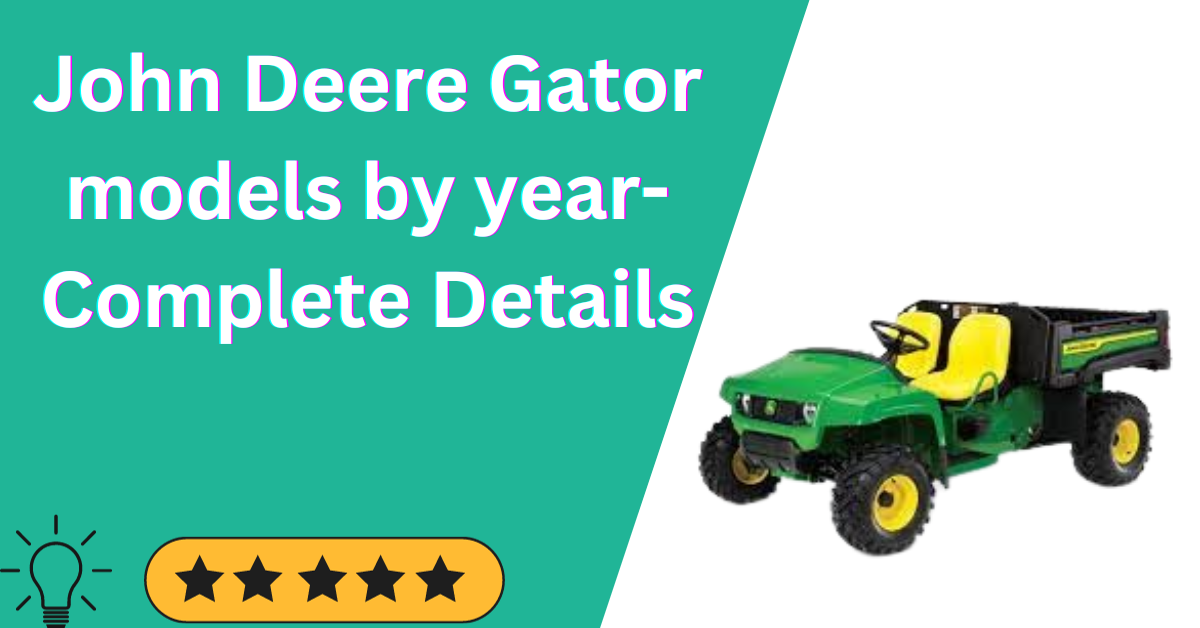John Deere Gator models have left an indelible mark on the utility vehicle landscape, offering a perfect blend of durability, performance, and innovation. In this extensive guide, we will not only trace the historical journey of John Deere Gator models by year but also delve into the specifics of each model, highlighting their unique features and specifications.
I. Understanding the Legacy of John Deere Gator
Before discussing the various models of John Deere Gator let’s understand its legacy.
A. Origins of John Deere Gator
The journey of John Deere Gator began with the introduction of its early models, designed to meet the demand for robust off-road transportation in agricultural settings. As the utility vehicle evolved over the years, it transitioned from a functional workhorse to a versatile machine with applications reaching beyond farming.
B. Significance in Agriculture and Beyond
The Gator’s impact on farming practices and its adaptability to various industries underscore its significance. From revolutionizing transportation in the agricultural sector to becoming an invaluable asset in construction and landscaping, the Gator has proven its versatility and reliability.
Also, explore What is considered high hours on a John Deere Gator.
Breakdown of John Deere Gator Models by Year
It is a time to discuss the various models of gators by year.
Original John Deere Gator (1992-1998)
John Deere Gator 6×4 (1992-1998)
- The first-ever John Deere Gator model.
- Equipped with a 6 hp single-cylinder Kohler engine.
- 4×2 rear-wheel drive for reliable off-road performance.
- Cargo capacity of 800 lbs and a manual dump bed.
John Deere Gator 4×2 (1995-1998)
- A smaller 4×2 model designed for maneuverability.
- Features a 5.5 hp single-cylinder Kohler engine.
- Cargo capacity of 600 lbs, offering versatility for various tasks.
Gator TS Series (1999-2006)
John Deere Gator TS 4×2 (1999-2006)
- An upgraded 4×2 model with increased power.
- Boasts a 10 hp twin-cylinder engine.
- Cargo capacity expanded to 1,000 lbs.
- Introduction of power steering in 2004 for improved control.
John Deere Gator TS 6×4 (2000-2006)
- Enhanced 6×4 model featuring a 16 hp V-twin engine.
- Cargo capacity increased to 1,200 lbs.
- Introduction of 4-wheel independent suspension for a smoother ride.
Gator XUV Models (2007-2013)
John Deere Gator XUV 620i (2007-2013)
- First Gator model with a fully enclosed cab.
- Powered by a 20 hp 3-cylinder diesel engine.
- 2-person capacity, equipped with power steering for user convenience.
John Deere Gator XUV 825i (2011-2013)
- Larger enclosed cab model with a 25 hp 3-cylinder diesel engine.
- 2-person capacity and a cargo capacity of 1,600 lbs.
Current John Deere Gator Models (2014-Present)
John Deere Gator RSX850i (2014-Present)
- Features a robust 50 hp 3-cylinder diesel engines.
- 2-person capacity, with speeds reaching up to 35 mph.
- Continuously variable transmission for seamless performance.
John Deere Gator XUV590i (2017-Present)
- Equipped with a powerful 59 hp 3-cylinder petrol engine.
- 2-person capacity with power steering and tilt steering for enhanced control.
- Impressive 2,000 lb towing capacity.
Features and Specifications
Now we discuss the features and specifications of these John Deere gator models.
Engine and Power Options
Understanding the power under the hood is crucial for choosing the right Gator model. From the early models with reliable engines to the latest ones with electronic fuel injection, the evolution of power options has been substantial. Specifications such as horsepower, torque, and fuel efficiency vary across models, catering to diverse user needs.
Chassis and Suspension
The chassis and suspension system plays a pivotal role in a utility vehicle’s off-road capabilities. Advances in independent suspension technology have significantly improved ride comfort and handling, making newer models like the Gator XUV835M stand out for their adaptability to various terrains.
Cargo and Towing Capacities
One of the defining features of John Deere Gator models is their ability to carry and tow substantial loads. Whether it’s the Gator TH 6×4 with its durable cargo box or the Gator XUV825i with increased payload capacity, users can choose a model that aligns with their specific hauling requirements.
Accessories and Attachments for the Gator
Here are some accessories and attachments for the John Deere gators.
Enhancing Utility and Versatility
The John Deere Gator isn’t just a utility vehicle; it’s a customizable workhorse designed to adapt to various tasks. With a wide array of accessories and attachments, users can tailor their Gator to meet specific needs. Here’s a glimpse into the world of Gator accessories:
- Cargo Box Extensions: Increase the hauling capacity of your Gator with cargo box extensions. Perfect for those larger loads that require additional space.
- Snow Blades and Blowers: Equip your Gator for winter tasks with snow blades and blowers. Tackle snow removal efficiently, ensuring clear paths on farms, driveways, or work sites.
- Winches: For added versatility, consider a winch attachment. Ideal for pulling heavy loads or getting out of challenging situations, a winch is a valuable addition to your Gator.
- Sprayers and Spreaders: Transform your Gator into an agricultural powerhouse by adding sprayers or spreaders. Perfect for applying pesticides, and fertilizers, or spreading seeds with precision.
- Roof and Windshield Options: Enhance comfort during varying weather conditions by adding a roof or windshield to your Gator. Shield yourself from the elements without sacrificing visibility.
- Lighting Accessories: Extend your work hours with additional lighting options. Whether it’s LED light bars for enhanced visibility or work lights for specific tasks, lighting accessories can be invaluable.
- Custom Seat Covers: Protect and personalize your Gator’s seats with custom seat covers. Choose from a variety of materials and designs to suit your style and preferences.
Tips for Choosing the Right Gator Model for Your Needs
Understanding Your Requirements
Picking the right John Deere Gator model involves considering your specific needs and applications. Here are some tips to guide you through the selection process:
- Identify Your Tasks: Clearly define the tasks you’ll be undertaking with your Gator. Whether it’s agricultural work, landscaping, or recreational activities, knowing your primary use will help narrow down your options.
- Consider Terrain Conditions: Assess the terrain where your Gator will operate. If you’ll be navigating rough and challenging terrains, models with advanced suspension systems and 4×4 capabilities may be more suitable.
- Evaluate Payload Requirements: Determine the typical loads you’ll be carrying. Different Gator models offer varying cargo capacities. Ensure that the model you choose can handle your expected payload.
- Factor in Passenger Capacity: If you anticipate carrying passengers regularly, consider models with multiple seating options. Some Gators are designed for two passengers, while others can accommodate more.
- Explore Power and Performance: Understand the power requirements for your tasks. Models with higher horsepower may be preferable for demanding applications, while more compact models might be suitable for lighter work.
- Think About Customization: If you envision adding specific attachments or accessories in the future, choose a Gator model with compatibility for such enhancements. John Deere provides a range of accessories to tailor your Gator to your unique needs.
- Test Drive and Experience: Whenever possible, take the opportunity to test drive different Gator models. Experiencing the vehicle firsthand will give you a feel for its handling, comfort, and overall performance.
Comparisons and Reviews
Comparative Analysis of Different Models
Conducting a comparative analysis is essential for users to make informed decisions. By examining the strengths and weaknesses of each model, potential buyers can identify the Gator variant that best suits their intended applications. This section will serve as a practical guide for individuals seeking the perfect balance between features and specifications.
User Reviews and Testimonials
Real-world experiences are invaluable when assessing the performance of John Deere Gator models. By incorporating user reviews and testimonials, this guide aims to provide prospective buyers with insights into everyday challenges, success stories, and how different models have met or exceeded user expectations.
Maintenance and Care Tips
Here are some maintenance tips your John Deere Gator models.
Routine Maintenance Guidelines
Owning a John Deere Gator comes with the responsibility of regular maintenance. This section will offer practical tips on routine maintenance, covering essential tasks such as oil changes, fluid checks, and the inspection and replacement of worn parts. Proper maintenance ensures the longevity and optimal performance of these utility vehicles.
Troubleshooting Common Issues
No vehicle is without its challenges, and the Gator is no exception. Equipping users with diagnostic tools and techniques, along with preventative maintenance measures, will empower them to address common issues effectively. Troubleshooting tips will guide users in maintaining the reliability of their Gators in various conditions.
Community and Enthusiast Insights
John Deere Gator Events and Gatherings
Building a sense of community among John Deere Gator enthusiasts is vital. This section will explore events and gatherings where users come together to share experiences, discuss modifications, and form connections based on their shared passion for these utility vehicles. It’s a testament to the thriving community that has developed around the John Deere Gator.
Customization and Personalization
The Gator community is known for its creativity and innovation in customizing these utility vehicles. From aftermarket accessories to DIY modifications and upgrades, users have a myriad of options to personalize their Gators. This section will inspire readers to explore the possibilities of making their Gator truly unique.
Conclusion
In conclusion, this comprehensive guide has not only provided a detailed historical overview of John Deere Gator models by year but has also delved into the specifics of each model. By understanding the features and specifications, prospective buyers can make informed decisions based on their unique needs and preferences.
The evolution of Gator models reflects John Deere’s commitment to innovation and customer satisfaction. Whether navigating challenging terrains on the farm, embarking on recreational adventures, or tackling demanding work environments, the John Deere Gator remains a symbol of reliability, versatility, and community.








